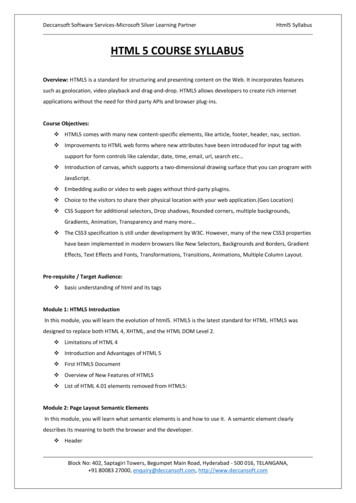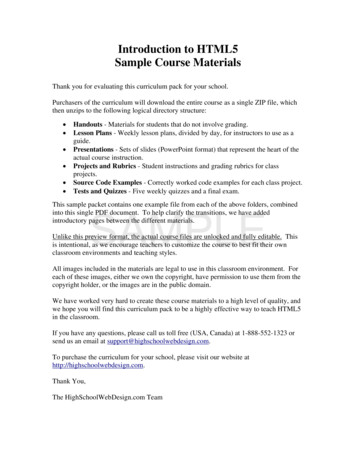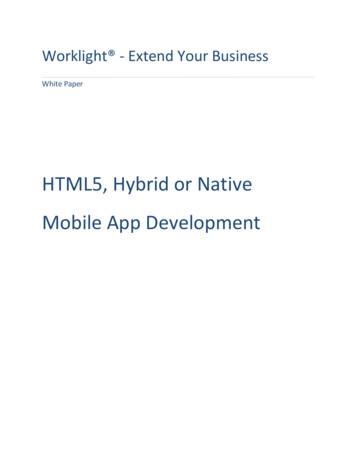
Transcription
Worklight - Extend Your BusinessWhite PaperHTML5, Hybrid or NativeMobile App Development
ContentsIntro . 3Introducing the Approaches . 3Native Applications. 3Mobile Web Applications . 6Hybrid Applications . 7Comparing the Different Approaches . 8Choosing the Right Approach .10Scenarios for the Native Approach .10Scenarios for the Web Approach .11Scenarios for the Hybrid Approach .11Summary .12About Worklight.132
IntroMany organizations taking their first steps to implement a mobile strategy are facing an importantdecision that will influence the results of this initiative. The process of choosing a developmentapproach for a mobile application, namely native, web or hybrid, entails many parameters such asbudget, project timeframe, target audience and application functionality to name a few. Each approachcarries inherent benefits and limitations, and finding the one that best addresses the organization’sneeds could be a challenging task.The purpose of this whitepaper is not to identify the best development approach, as such does notexist, but rather to list the pros and cons each carries and describe the different scenarios, or enterpriserequirements, that best fit one or the other.Introducing the ApproachesNative ApplicationsNative applications have binary executable files that are downloaded directly to the device and storedlocally. The installation process can be initiated by the user, or in some cases, by the IT department ofthe organization. The most popular way to download a native app is by visiting an application store suchas Apple’s App Store, Android’s Marketplace, or BlackBerry’s App World, but other methods exist andare sometimes provided by the mobile vendor.Once the app has been installed on the device, the user launches it like any other service the deviceoffers. Upon initialization, the native app interfaces directly with the mobile operating system, withoutany intermediary or container. The native app is free to access all of the APIs that are made available bythe OS vendor and, in many cases, has a unique look and feel that is typical of that specific mobile OS.To create a native app, developers must write the source code (in human-readable form) and createadditional resources such images, audio segments and various OS-specific declaration files. Using toolsprovided by the OS vendor, the source code is compiled (and sometimes also linked) in order to create3
an executable in binary form that can be packaged along with the rest of the resources and made readyfor distribution.These tools, as well as other utilities and files, are normally called the SDK of the mobile OS. Althoughthe development process is often similar across different operating systems, the SDK is platform-specificand each mobile OS comes with its own unique tools. The following table presents the different tools,languages, formats and distribution channels associated with the leading mobile operating systems.These differences across platforms result in one of the most critical disadvantages of the nativedevelopment approach – code written for one mobile platform cannot be used on another, making thedevelopment and maintenance of native apps for multiple OSs a very long and expensive undertaking.So why is it that in spite of this costly disadvantage, many companies choose to develop natively? Toanswer that question we will need to better understand the role of the APIs.The Application Programming Interface (API)Once the native application is installed on the mobile device and launched by the user, it interacts withthe mobile operating system through proprietary API calls that the operating system exposes. These canbe divided into two groups; Low-level API’s and High-level API’s.4
Low-level APIsIt is through these low-level API calls that the app can interact directly with the touch screen orkeyboard, render graphics, connect to networks, process audio received from the microphone, playsounds through the speaker or headphones, or receive images and videos from the camera. It canaccess the GPS, receive orientation information, and of course, read and write files on the solid statedisk, or access any other hardware element available today or in the future.High-level APIsIn addition to providing the low-level hardware-access services we just mentioned, mobile operatingsystems also provide higher-level services that are important to the personal mobile experience. Suchservices include processes like browsing the web, managing the calendar, contacts, photo album, andof course the ability to make phone calls or send and receive text messages.Although most mobile OSs include a set of built-in applications that can execute these services, a setof exposed high-level APIs is made accessible for native apps as well, allowing them to access many ofthe important services mentioned above. Other APIs let downloadable apps access various cloudbased services that are provided by the OS vendor, such as Push Notifications or In-App Purchases.The GUI ToolkitAnother important set of APIs that the OS provides is the GUI toolkit. Each mobile OS comes with itsown set of user interface components such as buttons, input fields, sliders, menus, tab bars, dialogboxes, and more. Apps that make use of these components inherit the look and feel of that specificmobile OS which normally results in a very smooth user experience.It’s important to note that different mobile platforms carry unique palettes of UI components. As aresult, apps that are designed to work across multiple operating systems require the designer to befamiliar with the different UI components of each OS.Although APIs are OS-specific and add much complexity and cost to the development of multiple nativeapps, these elements are the only means of creating rich mobile applications that make full use of all thefunctionality that modern mobile devices have to offer.5
Mobile Web ApplicationsModern mobile devices consist of powerful browsers that support many new HTML5 capabilities, CSS3and advanced JavaScript. With recent advancements in this front, HTML5 signals the transition of thistechnology from a “page definition language” into a powerful development standard for rich, browserbased applications.A few examples of the potential of HTML5 include advanced UI components, access to rich media types,geo-location services and offline availability. Using these features and many more that are underdevelopment, developers are able to create advanced applications using nothing but web technologies.Let us distinguish between two extreme web-app approaches. We are all familiar with mobile browsingand mobile-optimized web sites. These sites recognize when they are accessed by a smartphone andserve up HTML pages that have been designed to provide a comfortable “touch experience” on a smallscreen size. But some companies go even further and enhance the user experience by creating a mobilewebsite that looks like a native app and can be launched from a shortcut that is indistinguishable fromthat used to launch native apps.There is a wide range of possibilities between these two extremes, with most websites implementingtheir own mix of features.Mobile web apps are a very promising trend. To capitalize on this trend and help developers build theclient-side user interface, a growing number of JavaScript toolkits have been created, such as SenchaTouch and jQuery Mobile, which generate user interfaces that are comparable in look and feel to native6
apps. Both execute entirely within the browser of the mobile device and make use of the newestJavaScript, CSS and HTML5 features that are available in modern mobile browsers.One of the most prominent advantages of a web app is its multiplatform support and low cost ofdevelopment. Most mobile vendors utilize the same rendering engine in their browsers, WebKit – anopen source project led mostly by Google and Apple that provides the most comprehensive HTML5implementation available today. Since the application code is written in standard web languages thatare compatible with WebKit, a single app delivers a uniform experience across different devices andoperating systems, making it multiplatform by default. But these advantages are not without a price.Despite the potential and promise of web technologies in the mobile space, they still carry significantlimitations. To understand these limitations we need to explain how web applications operate.Unlike native apps, which are independent executables that interface directly with the OS, web apps runwithin the browser. The browser is in itself a native app that has direct access to the OS APIs, but only alimited number of these APIs are exposed to the web apps that run inside it. While native apps have fullaccess to the device, many features are only partially available to web apps or not available at all.Although this is expected to change in the future with advancements in HTML, these capabilities are notavailable for today’s mobile users.Hybrid ApplicationsThe hybrid approach combines native development with web technology. Using this approach,developers write significant portions of their application in cross-platform web technologies, whilemaintaining direct access to native APIs when required.The native portion of the application uses the operating system API’s to create an embedded HTMLrendering engine that serves as a bridge between the browser and the device API’s. This bridge allowsthe hybrid app to leverage all the features that modern devices have to offer.App developers can choose between coding their own bridge or taking advantage of ready-madesolutions such as PhoneGap – an open source library that provides a uniform JavaScript interface toselected device capabilities that is consistent across operating systems.7
The native portion of the app can be developed independently, but some solutions in the marketprovide this type of a native container as part of their product, thus empowering the developer with themeans to create an advanced application that utilizes all the device features using nothing but weblanguages. In some cases, a solution will allow the developer to leverage any native knowledge he or shemight have to customize the native container per the unique needs of the organization.The web portion of the app can be either a webpage that resides on a server or a set of HTML,JavaScript, CSS and media files, packaged into the application code and stored locally on the device.Both approaches carry both advantages and limitations. HTML code that is hosted on a server allowsdevelopers to introduce minor updates to the app without going through the process of submission andapproval that some app stores require. Unfortunately, this approach eliminates any offline availability asthe content is not accessible when the device is not connected to the network. On the other hand,packaging the web code into the application itself allows for better performance and accessibility, butdoes not allow for remote updates. The best of both worlds can be achieved by combining the twoapproaches. Such a system is architected to host the HTML resources on a web server for flexibility, yetcache them locally on the mobile device for performance.Comparing the Different ApproachesSo to summarize, let’s take a look at all three development approaches compared to each other.8
Native excels in performance and device access, but suffers in cost and updates. Web is much simpler,less expensive and easier to update, but is currently limited in functionality and cannot achieve theexceptional level of user experience that can be obtained using native API calls. The hybrid approachprovides a middle ground which, in many situations, is the best of both worlds, especially if thedeveloper is targeting multiple operating systems.As can be inferred from the table above, no single approachdelivers all of the benefits all of the time. Choosing the rightapproach depends on the specific needs of the organizationand can be driven by many parameters such as budget,timeframe, internal resources, target market, requiredapplication functionality, IT infrastructure and many others.But one thing is clear; most companies today face an obvioustradeoff between user experience and application9
functionality on one hand, and development costs and time to market on the other. The challengebecomes choosing the right development approach that will balance the organization’s requirementswith its budget and time-to-market constraints.Choosing the Right ApproachThe following is a list of scenarios to help guide organizations in the process of choosing an approach:Scenarios for the Native ApproachExisting Native Skills - One of the main arguments against the native approach is its lack of multiplatformsupport. Organizations asking to develop an application for multiple mobile platforms need to hire newemployees, or train its in-house developers in a variety of native languages. Organizations that havesuch native skills in-house are able to leverage them without significant new investments.A Single Mobile OS - In some cases, an organization will aim to release a mobile application to a limitedtarget audience – one that is known to use a single mobile OS. For example, consider a scenario wherean internal application is distributed within an organization that issues a BlackBerry device to itsemployees. In this case, achieving multiplatform coverage might not be a priority, and as developing asingle native application requires a limited set of skills and tools, this approach can make much sense.Native Functionality - Some applications are built around a single functionality. Take Skype for example,VOIP and access to the user’s contacts are key elements of the app and, given available technologiestoday, can only be developed natively. For such applications, web languages are simply not yetsufficiently evolved and are far from capable of achieving the desired functionality.Rich UI Requirements - For game-like applications that require a rich user interface that provides realtime responsiveness, web technologies do not yet provide adequate solution. For applications with suchrequirements, developers are still better off taking the native approach.10
Scenarios for the Web ApproachDirect Distribution - Some organizations prefer distributing their apps in a manner that is controlledinternally and is not subjected to what can sometimes turn into a long and uncertain approvalprocesses. In such cases, using purely web languages can completely circumvent the app store processand allow the organization to fully control the distribution of the app as well as it periodical updates.Pilot App - When comparing the costs and time to market involved in the development of a native vs. aweb app, using the web approach to create a pilot version of the app can be a compelling and costeffective tactic. Once the concept has been proved, the organization can choose to create a newapplication from scratch or leverage portions of the existing code in a hybrid application.Visibility - Further to the distribution we already mentioned, another benefit of creating a webapplication is its visibility in search engine results which, in many cases, expose the application to alarger audience than that available through the app store alone.Scenarios for the Hybrid ApproachBalancing the Tradeoff - Using the hybrid approach, companies can enjoy the best of both worlds. Onone hand, the native bridge, allows developers to take full advantage of all the different features andcapabilities that modern mobile devices have to offer. On the other, all the portions of the code that arewritten using web languages can be shared among different mobile platforms, making the developmentand ongoing maintenance process centralized, shorter and cost-effective.In-house Skills - Web development skills are very common and can easily be found in manyorganizations. By choosing the hybrid approach, supported by the right solution, web developers areable to build applications with nothing but web skills such as HTML, CSS and JavaScript, while deliveringa native user experience.Future Considerations - HTML5 is rapidly growing in both availability and capabilities. Many analystspredict that it is likely to become the default technology for front-end application development. Bywriting most of the app in HTML, and using native code only where needed, companies can make surethat the investments they make today do not become obsolete tomorrow, as HTML functionalitybecomes richer and addresses a wider range of the mobile requirements of modern organizations.11
SummaryAs mobile applications continue to take a center role in the business landscape, organizations aroundthe world are mobilizing a growing number of mission-critical services. Many companies are striving tofind the optimal development approach to achieve their goals, but what many are quickly realizing isthat each carries inherent limitations and no single approach can address all the growing needs andcomplexity of the modern mobile enterprise.As this paper attempts to show, the answer lies not in one development approach, but rather in aflexible solution; one that can harness the benefits that each provides and support not only thedevelopment of a first mobile app, but of all future apps, regardless of their development approach.But the choice between hybrid, native and web, although certainly a major one, is not the only one.Companies forming their mobile strategy must also consider the future of this market; Further fragmentation of mobile devices and technologies, which in turn, will continue to increasethe overall costs and complexities that are associated with mobile application development,integration and ongoing management; Accelerated mobile adoption by consumers and within the enterprise increasing the requirementsaround security, scalability and ongoing control; New device features and complementing technologies such as near-field communication, geolocation, augmented reality, social networks, and others which will undoubtedly give rise to newtypes and new use cases of mobile apps; And new distribution channels for the apps, both public and private, allowing organizations to easilyplace the apps in the hands of the user, quickly deploy updates and manage its entire portfolio ofapps without going through a long submission and approval process.Taking all these parameters into consideration, companies must choose a solution that is not onlyflexible enough to support all types of apps but would also support the secure and scalable integrationof the apps into the IT infrastructure as well as allow them to monitor and control their entire portfolioof applications from one centralized interface.12
About WorklightWorklight is a leading mobile application platform that enables organizations to create, run and managerich applications for smartphones, tablets and other environments with the highest levels of developerproductivity, enterprise delivery and dynamic control. Many of the world’s largest companies rely onWorklight to provide optimal user experiences across more devices while radically reducing time tomarket, development cost and ongoing maintenance effort.For further information please visit our website – www.worklight.comJoin the Worklight Developer Zone for an evaluation version of our platform – http://dev.worklight.com13
HTML5, Hybrid or Native . Introducing the Approaches Native Applications Native applications have binary executable files that are downloaded directly to the device and stored locally. The installation process can be initiat

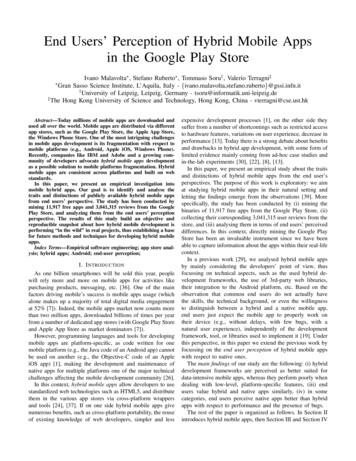
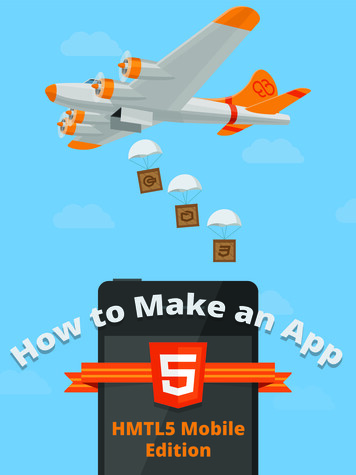
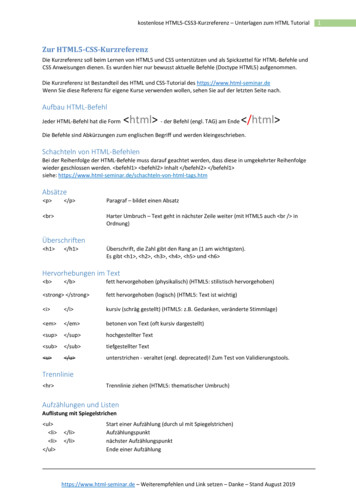
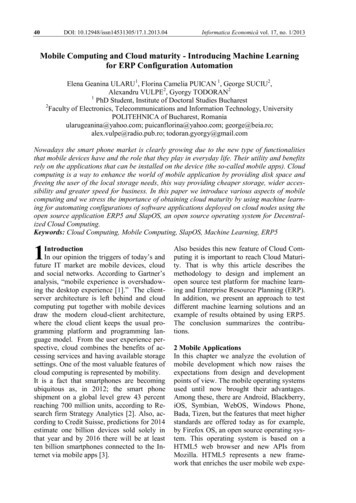
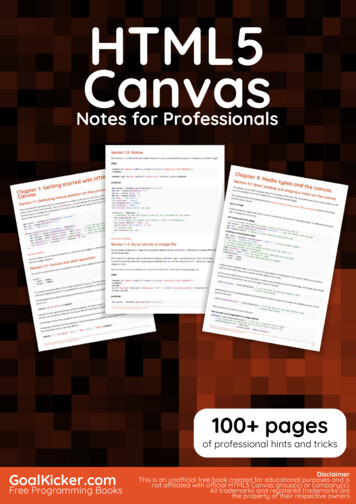
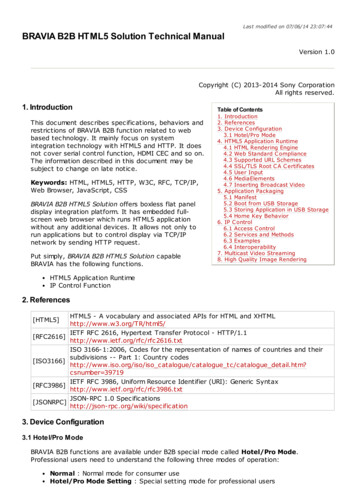
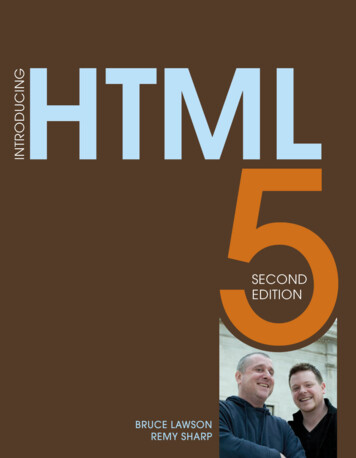
![[MS-HTML5]: Microsoft Edge / Internet Explorer HTML5 .](/img/13/ms-html5-170314.jpg)
